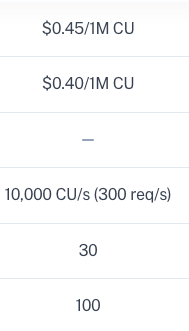Name out: in case you’re an investor who has frolicked on this a part of the market, I’d love to talk to you!
Okay, so my earlier article “How reliable is your node?” obtained a good quantity of traction and responses. I assumed I’d observe it up with one other article, this time on the opposite facet of issues: pricing and structural market dynamics. I’d advocate studying that earlier than studying this text because it assumes prior data.
RPCs are important as they’re the way in which all of us work together with any blockchain, they mainly are the blockchain. Now usually validator nodes are nicely lined as a result of you may earn a simple 5% in your tokens for clicking a button. Full nodes are a thankless job that don’t get you any incentive (these are what RPCs normally are). If we’re speaking about archive nodes, somebody higher be paying you in any other case you’ve gotten near 0 incentive to working one.
Due to this fact, massive corporations run these nodes and occupy market share. The market map seems a little bit one thing like this:
So whenever you’re an engineer searching for a RPC supplier, you normally simply go together with one thing you’ve gotten heard of that works and has a very good model aka the “you 100% have heard of list”. This isn’t lazy, this can be a affordable assumption: “surely the companies that are large and you see all over should be fine”. Effectively from my earlier article, we noticed that wasn’t solely true and there may be massive variances in efficiency. On this article we’re going to the touch on the economics of this market in its entirety.
Beginning off with the: “100%-You-Have-Heard-Of” corporations. These are corporations are closely funded and have had cash thrown at them by traders over the previous few years.
These aren’t small numbers by any means. It’s exactly due to this scale of cash that you simply heard of those corporations within the first place. Now one would argue that might be a very good spend of cash within the first place, nearly. Granted these corporations have many different product traces they’re spinning up, however working nodes is the core of what they do and wish to make sure they get proper.
The “You May Have Heard Of” corporations have are available later and have needed to compete and create wedges available in the market by providing extra chains, ancillary providers or purely competing on price. They will play this recreation and transfer quicker than the bigger gamers as a result of their expense overhead is far smaller: they don’t have a $25m-$50m/yr payroll to maintain. They are often extra experimental and extra aggressive. Nevertheless, their greatest problem is that folks haven’t heard of them, and neither have they got the sheer $ sources to compete with the most important gamers in gross sales or advertising.
Can’t they compete purely on efficiency? As I outlined within the prior article, measuring RPC efficiency is non-existent within the crypto trade and everybody’s at midnight guessing. There are providers like Atlas from 1kx that try and benchmark these stats however they miss nuances like: tip of chain measurements, sheer RPC load, technique degree breakdowns, concurrency measurements, node geographies, and most significantly: price RELATIVE to efficiency. It doesn’t matter in case you have the very best nodes however they value 100x extra.
I discover this section of the market will get squeezed probably the most: they don’t have robust manufacturers and neither have they got nice nodes. They carry out someplace in-between on each of those dimensions.
So if efficiency isn’t clear, then absolutely pricing have to be. Proper? Mistaken.
You see, the RPC market has fallen in love with what I name the “Compute Unit” confusion. What you mainly do is create a brand new metrics that clients don’t perceive, after which drive them to grasp it — or silently cost extra.
Let’s take this easy RPC pricing plan which will or might not be hypothetical.
So the primary query you ask is, nicely what’s a compute unit?
A compute unit is a measure of what number of sources (CPU, RAM, disk, and so on) an API technique consumes. A easy request like blockNumber solely consumes 10 CUs, whereas a extra complicated request like eth_call consumes 26 CUs. You’ll be able to see a full breakdown of our compute models on our docs.
Alright, so what occurs whenever you go to the docs? Effectively, you get an extended listing of RPC strategies (Ethereum has 70+ alone). Nevertheless, you additionally should think about what chain you’re on.
So the matrix now turns into:
-
What number of compute models do you get per greenback
-
What strategies are you calling and work out what number of compute models does it take
-
Apply some a number of primarily based on the chain you’re calling the tactic (Arbitrum eth_call will value extra CUs than Ethereum eth_call)
Oh additionally do not forget that compute unit calculations are totally different per supplier so good luck attempting to normalize all of this (except you’re blissful constructing massive quantitative fashions of your RPC suppliers’ pricing fashions).
Absolutely that’s all it’s important to maintain up with? Not precisely. You see in that screenshot there’s a little bit bit that claims “300 requests per second”. Now if we scroll down on that very same web page it says the 300 requests are literally 10,000 Compute Models! These are very various things.
Let’s pull up the compute unit pricing desk to really perceive this in additional element.
Effectively turns on the market are actually two kinds of compute models, common compute models and throughput compute models! So in case you had been doing something with traces, you’d solely must make 10 debug calls per second to make the most of your 10,000 compute unit/second quota! Should you’re utilizing one thing a bit extra tame like eth_accounts then positive you’d get 1000 requests/second however you name these strategies much more usually. All that is to say that you’ve one other variable you’re secretly being charged on or being pushed by: throughput.
To recap the levers that go into RPC buying selections:
-
Compute models per greenback
-
Compute models per technique
-
Compute models by chain
-
Compute models per second (throughput)
Now right here’s the true kicker: all of those can silently be modified with out making it appear to be the price has gone up! We’ve got discovered that previously yr, our RPC suppliers have elevated prices on us by wherever from 5x-10x! Sure. You learn that proper.
Even if you wish to use a number of RPCs to keep away from getting monopolized, it’s important to make sure you route your requests intelligently primarily based on a series/technique foundation because the pricing between chain/strategies between suppliers may be on the order of 10x. You even have to make sure you construct correct monetary fashions always monitoring totally different suppliers’ pricing, which additionally always modifications. This additionally assumes that your second supplier helps the chain you’d wish to fall again on.
Alright, so why not simply use inexpensive suppliers which are cheaper? Effectively, the fact is that you simply don’t know what their efficiency truly is like as acknowledged earlier within the article. These are smaller corporations that don’t have the sources of the bigger suppliers so the potential of failure is far increased and your recourse is much smaller (their model isn’t in jeopardy as a lot).
To make sure you need to use a smaller supplier safely, you should route failures appropriately. Nevertheless, routing comes with its personal challenges corresponding to:
-
Guaranteeing you map chains/strategies to suppliers that help the pair
-
Preserve up with the costs to your suppliers and select intelligently primarily based on the price
-
Perceive what’s a legitimate error versus a person failure (the RPC fails versus the RPC request is invalid)
-
Guaranteeing {that a} success is definitely successful and doesn’t return invalid knowledge
-
Know when to chop off a supplier versus ready for them to succeed
-
Respecting price limits of whichever supplier you’re utilizing when routing
As you may see, what began as a easy downside has in a short time spun uncontrolled with many layers of complexity that must be tamed. A easy if/else assertion gained’t suffice because of the above pricing components alone, you continue to want to grasp efficiency.
The results of all of this can be a RPC market that’s inefficient the place the highest suppliers achieve market share slowly squeezing their high clients like frogs in scorching water and those who can’t afford it or want far more dependable providers, to construct customized options to resolve the entire above issues.













